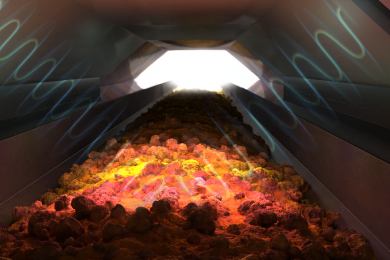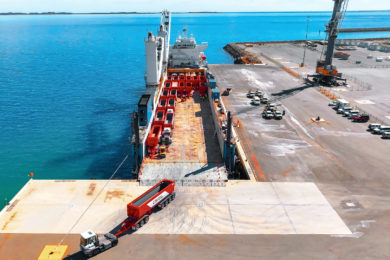CSIRO’s partnership with industry players Advisian and RFC Ambrian to produce the next generation bulk ore sorting technology is now being closely looked at by potential buyers.
NextOre, the company being formed by the three partners, has developed an advanced sensor system that takes advantage of magnetic resonance technology. It illuminates batches of ore with short pulses of radio waves, assessing ore grade and enabling high tonnage sorting at extremely high speeds.
NextOre’s ore sorter is able to detect the magnetic resonance signatures of many minerals, including the most common economically significant iron-and copper-bearing minerals. It also has the ability to detect arsenic-bearing minerals that are often positively correlated with gold in sulphide ore deposits. It can see through large ore batches in real time as they pass by the sensors contained in an open-ended chamber.
The magnetic resonance technology (MRT) is often compared with the way MRI technology is capable of “seeing into” human bodies. RFC Ambrian associate director and acting CEO of NextOre, Chris Beal, says the industry reaction to this ore sorting technique has been very positive. It can pass material through at the rate of 5000 tonnes per hour, being able to distinguish “the wheat from the chaff” in seconds.
“The R&D phase is over,” Beal says. “It’s now about getting the industry to implement it and while we can’t yet mention names, most of the global mining houses investigating operational improvements through the application of advanced technologies are looking at this solution.”
As a corporate finance company specialising in resources, RFC Ambrian has taken on an unusual additional role of working as the commercialiser and lead marketer of the product in conjunction with Advisian and CSIRO.
Beal says mining companies are not normally taken to the early adoption of radical new technologies, even if the benefits are clear and significant.
“Selling equipment and getting it in front of the right people in some of these big mining companies is not normally what investment bankers or corporate finance people do.
“Our job is not just to get companies considering this solution, but to ensure they consider it at the right point in their development process or at the right approval level.”
Advisian was also brought into the partnership because of its expertise in engineering solutions including bulk ore handling. The sensing mechanism has to be paired with conveyor and materials handling equipment and suitably matched with the size of the operation.
CSIRO team leader, David Miljak, says the ore sorter is likely to be most suited to the copper mining industry as it can detect copper minerals at extremely low grades. He calls high tonnage ore sorting the “holy grail’ of the mining industry.
Other ore sorting conveyor machines tend to do the sorting on a rock-by-rock basis, with sensors often only penetrating “skin deep” — in other words, detecting ore particles on the surface of the passing material. By using magnetic resonance radio waves NextOre’s solution not only penetrates all of the ore presented on the conveyor, but reads the different mineral radio signals, informing sorters what is present in seconds.
Dr Miljak adds that it is extremely effective at detecting levels of arsenic that often occur along with gold orebodies. If the sensors detect abnormally high concentrations of arsenic minerals, then it can instruct equipment to selectively reject pods of ore, enhancing a deposit’s economic viability.
He believes the processing costs for a big mining operation will drop radically for each pound of copper or ounce of gold produced — as much as 20% in some mines.
“That’s according to the numbers we’ve put together. For an operation which spends half a billion dollars a year just to keep mining, that’s a big deal.”
There is also the positive environmental aspect of the process. “If we can see what’s in the passing material faster, it means a smaller processing plant that uses less electricity, less water and produces less waste material thrown into tailings and dams.
“For every tonne of metal, we offer a much lower environmental footprint. For mines that are constrained by water usage, that’s a bonus,” Dr Miljak says.
CSIRO’s Nick Cutmore, who heads up the project’s research team, says the sensing technology was evaluated at the Newcrest Ridgeway mine near Orange in New South Wales, Australia. The testing demonstrated throughput capacity, accuracy and response times that improve significantly on competing sensing technologies. “NextOre’s ore sorter should prove useful for both older, mature mines as well as undeveloped mines. It can extend the life of older mines and make undeveloped mines viable in the first place,” Dr Cutmore says.
The big problem for mines is that once they have worked out the higher grade material, they’re left with the lower grade, which may be uneconomic without advances in mining or processing technologies.
“This technology allows a mine like this to continue to get a high enough grade to make it economic. By being able to process lower grade ore, we’re extending the life of the mine.”
There are many undeveloped copper mines throughout the world, particularly in North and South America as well as in Australia. “This could help these countries to decide to develop a mine in the first place,” Dr Cutmore says.
The South Australian Government has set a bold target to triple copper production over the next fifteen years as an important part of boosting its economy. NextOre’s ore sorting technology would dovetail nicely with that push.
“A lot of these projects in South Australia are dealing with low grade material, and for it to be viable, we need brand new ways to process the copper and grow the economy. The technology we are offering is one way to do this,” Dr Cutmore says.
NextOre’s bulk ore sorting solution is currently available for deployment at mine sites.










